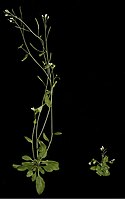
Photo from wikipedia
Abstract Potato tuber moth (PTM) Phthorimaea operculella, also known as tobacco splitworm, is an important pest of tobacco plants. The knowledge on the interaction of tobacco plant volatiles and PTM… Click to show full abstract
Abstract Potato tuber moth (PTM) Phthorimaea operculella, also known as tobacco splitworm, is an important pest of tobacco plants. The knowledge on the interaction of tobacco plant volatiles and PTM behavior is limited. To clarify the effect of tobacco plant volatiles on the orientation and oviposition behaviors of PTM and to identify potential compounds for PTM control, tobacco plant volatiles were collected by headspace collection method, and volatile compounds were identified by gas chromatography-mass spectrometry. Thirteen electrophysiological active compounds were screened by employing coupled gas chromatography-electroantennogram detection and from which nine available compounds were further verified by electroantennogram recording. cis-3-Hexen-1-ol showed significant attractant effect on the orientation behaviors of both male and female moths. Nonanal and decanal could only attract females, while octanal exhibited repellent effect on males. Oviposition selection experiment indicated that nonanal, decanal, decane and methyl hexadecanoate could stimulate the gravid females to lay more eggs, while octanal and 2,6-bis(1,1-dimethylenthyl)-4-methyl phenol inhibited their oviposition. Our study added more compounds to the list that could serve as potential PTM deterrents or attractants.
Journal Title: Journal of Integrative Agriculture
Year Published: 2020
Link to full text (if available)
Share on Social Media: Sign Up to like & get
recommendations!